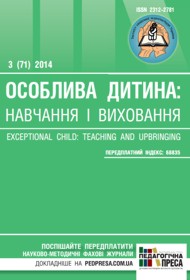Sign language educational translator: staffing the communicative needs of sign language education applicants
Abstract
This article highlights the meaning of the new concepts for «sign language learners» and «sign language educational translator» for Ukraine. Attention is focused on the erroneous use of the outdated terms “fingerprint translator” and “sign language interpreter”.
The content of Art. 21 of the Salamanca Declaration on the Importance of Sign Language as a Means of Communication and Access for Persons with Hearing Impairments to Education through National Sign Language, both in special schools and in inclusive classes, groups of educational institutions.
Briefly indicated and justifiably the difference in overcoming the communication barrier by sign-speaking people compared with hearing representatives of other national minorities who use only verbal language.
Accordingly, two strategies are outlined to meet the communicative needs of deaf people during their education: modification and adaptation of the educational environment. The services providing adaptation of the educational environment to the communicative needs of deaf learners are characterized.
The requirements for a sign language translator in an educational institution, outlined in the Handbook of qualification characteristics of professions of workers, are outlined and the modern functions of an educational sign language translator are formulated.
Statistical data of the Ukrainian Society of the Deaf are given for the number of relevant specialists in higher education institutions where deaf people who use sign language are trained.
References
2. Класифікатор професій. ДК 003 : 2010 / [розробники: М. Гаврицька, В. Глоба, Т. Гречушкіна та ін. ]. – К.: соцінформ, 2010, 746 с.
3. Адамюк Н. Б. до питання про реальний стан навчання інвалідів зі слуху в україні /н. Б. адамюк // зб. наук. праць VII Міжнародної науково-практичної конференції [актуальні проблеми навчання та виховання людей з особливими потребами]. (22–23 листопада 2006 р.) – К.: Університет «Україна», 2006. – с. 76 – 84.
4. Адамюк Н. Б. Перекладач у навчальному закладі як модель жестової мови для глухих студентів /н. Б. адамюк. – збірник наукових праць «педагогічні науки». випуск lXIX. – том 3, херсон.: херсонський державний університет, видавничий дім «гельветика», 2016. – с. 7–12.
5. Адамюк Н. Б. Проблемні аспекти отримання вищої освіти в україні жестомовними глухими особами /н. Б. адамюк. – збірник наукових праць «педагогічні науки». Випуск lXXXIII. – том 1, херсон. : херсонський державний університет видавничий дім «гельветика, 2018. – с.194–202.
6. Адамюк Н. Б. Сучасний погляд на жестову мову / н. Б. адамюк. – освіта осіб з особливими потребами: шляхи розбудови: зб. наук. праць: вип. 14 / за ред. в. в. Засенка, а. а. колупаєвої. – 2018. – с.11–20


